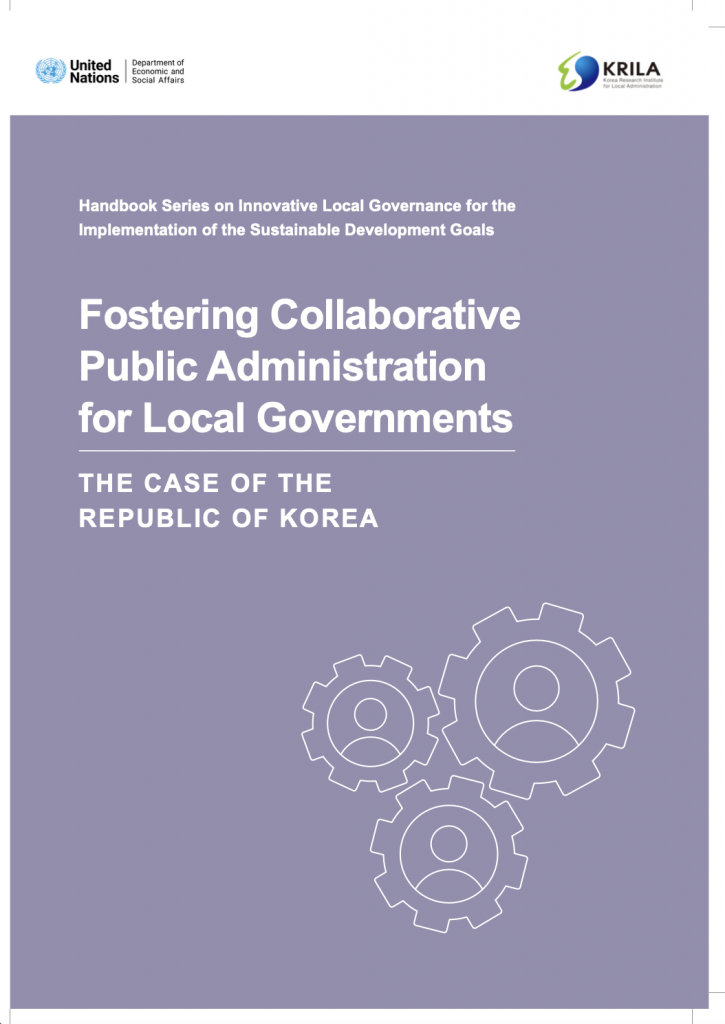
This handbook explains the concepts, attributes and approaches of collaborative administration and specifically introduces practical cases of collaborative public administration in local governments in the Republic of Korea. Collaborative public administration is recognized as a method that can effectively respond to complex and diverse administrative demands, but there are many obstacles in applying it on a practical level.
Chapter 1 establishes the scope and concept of collaborative public administration. Collaborative public administration is a method of solving social problems and promoting policies through interactions between entities in the public and private sectors such as sharing human resources, financial resources and expertise. In other words, it is an act of increasing the scope of collaboration between multiple subjects trying to obtain specific results and achieve common goals by utilizing administrative resources. Collaborative public administration often is limited to interactions between departments and institutions in the public sector, with private sector entities excluded. Given the recent trend of private participation in public policy processes, it is no longer appropriate to exclude public-private cooperation when considering collaborative public administration.
Chapter 2 presents the core considerations and contents necessary in the process of collaborative public administration, including:
Diversity of Participants. Collaborative administration can include both public and private sector entities. Considering the entities participating, collaborative administration can be divided into interactions between public-public or public-private sectors.
Applicable service fields. Collaborative public administration can be applied to a wide range of public services without restrictions on limited fields. The administrative service fields can be largely divided into hardware and software-related services and can be subdivided into areas such as education, village community, culture/tourism, social welfare, life/convenience, safety/security, regional development/environment and administrative management.
Policy effects and targets. When the performance of the collaborative public administration improves the quality of services provided to the private sector, the target is external customers (e.g., citizens). When the performance improves the work process in the public policy process, the target is internal customers (e.g., public sector entities, local governments themselves).
Resource sharing. In general, there is a difference in the level of human and material resources held by each entity participating in collaborative public administration. For the collaboration to proceed smoothly and achieve results, a complementary relationship must be formed through resource sharing among the participants.
Innovation. Innovation in public policies often is measured based on the use of science and technology. In this context, the application of science and technologies in public services is a factor to be considered in collaborative public administration.
Sustainability. The foundation must be laid (e.g., legal systems, departments and manpower) for the long-term and continuous operation of collaborative public administration systems.
Chapter 3 is a case study of collaborative public administration in the Republic of Korea. It includes information on participants’ roles and the results of the collaborations. Three local government collaboration cases are analysed: roadkill reporting system, Chungcheongnam-do; certification of climbing the nine peaks in the Yeongnam Alps, Ulju-gun, Ulsan; and one-stop integrated finance, employment and welfare services, Buk-gu, Gwangju. The cases are analysed based on the factors to be considered in the collaborative public administration and the differences and strengths of each are examined.
Chapter 4 categorizes collaborative public administration based on the aforementioned key considerations and case study results. This chapter newly derives two collaborative public administration models. Each model shows differences in attributes of the participating entities, collaboration period and composition content. The social innovation collaboration model is conducted by public and private sector entities for external customers from a mid- to long-term perspective. The administrative innovation collaboration model is an internal customer-oriented collaborative model conducted by public sector entities at a relatively short-term perspective.
Fostering Collaborative Public Administration for Local Governments.pdf



